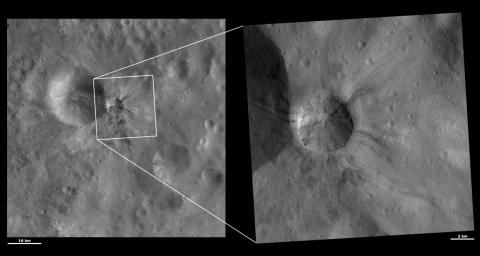These Dawn framing camera (FC) images of Vesta show Aelia crater at both HAMO (high-altitude mapping orbit) and LAMO (low-altitude mapping orbit) resolutions. The left image is the HAMO image and the right image is the LAMO image. Aelia is the crater offset from the center of the LAMO image. The LAMO image is approximately 3 times better spatial resolution than the HAMO image. In images with higher spatial resolutions smaller objects can be better distinguished. The large streaks of dark and bright material inside and outside of Aelia crater can be seen in both the HAMO and LAMO images. Fine-scale intermingling of the dark and bright streaks can be seen in the LAMO image, along with tiny boulders on the slump that covers the top part of the rim of Aelia. This slump causes the dichotomy between the part of Aelia's rim that is fresh and sharp and the part that is covered by the slump, which looks much more degraded.
These images are located in Vesta's Lucaria Tholus quadrangle, in Vesta's southern hemisphere. NASA's Dawn spacecraft obtained the left image with its framing camera on Oct. 23, 2011. This image was taken through the camera's clear filter. The distance to the surface of Vesta is 700 kilometers (435 miles) and the image has a resolution of about 63 meters (207 feet) per pixel. This image was acquired during the HAMO (high-altitude mapping orbit) phase of the mission. NASA's Dawn spacecraft obtained the right image with its framing camera on Jan. 10, 2012. This image was taken through the camera's clear filter. The distance to the surface of Vesta is 272 kilometers (169 miles) and the image has a resolution of about 18 meters (59 feet) per pixel. This image was acquired during the LAMO (low-altitude mapping orbit) phase of the mission.
The Dawn mission to Vesta and Ceres is managed by NASA's Jet Propulsion Laboratory, a division of the California Institute of Technology in Pasadena, for NASA's Science Mission Directorate, Washington D.C. UCLA is responsible for overall Dawn mission science. The Dawn framing cameras have been developed and built under the leadership of the Max Planck Institute for Solar System Research, Katlenburg-Lindau, Germany, with significant contributions by DLR German Aerospace Center, Institute of Planetary Research, Berlin, and in coordination with the Institute of Computer and Communication Network Engineering, Braunschweig. The framing camera project is funded by the Max Planck Society, DLR, and NASA/JPL.
More information about Dawn is online at http://www.nasa.gov/dawn and http://dawn.jpl.nasa.gov.

 Planetary Data System
Planetary Data System












